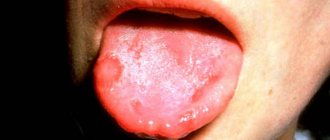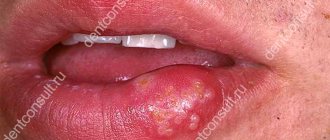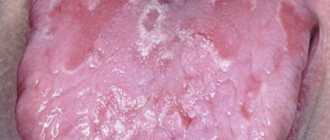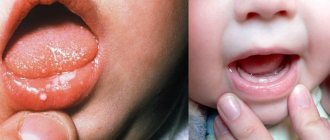What is stomatitis
Stomatitis is a group of dental diseases that have similar manifestations. The disease looks like inflammation of the oral mucosa, localized on the inside of the cheeks, on the palate, gums, lips, and tip of the tongue. In rare cases, lesions are diagnosed in the pharynx, on the tonsils - such formations are the most difficult to notice.
Typically, stomatitis develops as an independent disease as a result of a sharp drop in immunity, chronic infection, or allergies. The disease is contagious only in rare forms, but if left untreated, it quickly spreads through the mucous membranes of the oral cavity - it can provoke a sharp rise in temperature, causing weakness and prolonged malaise.
Stomatitis also manifests itself as a complication or symptom of other diseases - influenza, gastritis, diabetes, bronchial asthma, HIV infection.
Stomatitis: symptoms
Since stomatitis is an inflammatory process, the manifestations of the disease are standard. Dentists identify signs of stomatitis:
- redness, formation of a hyperemic area in the oral cavity;
- swelling, swelling of the affected area;
- the appearance of erosions, ulcers, aphthae;
- itching, burning at the site of ulcer formation;
- gray or yellowish coating along the edges of the canker sores;
- pain when talking, opening the mouth, or touching the mucous membranes of the mouth;
- bleeding due to accidental damage to plaque;
- local temperature increase.
Patients also note an unpleasant taste in the mouth, a putrid odor, and loss of appetite.
Forms of the disease
Candidal stomatitis is a fairly common disease that manifests itself in various forms. The symptoms can determine how much it is progressing. Treatment depends on the severity of the disease.
In the earliest stages, a mild form of the disease appears. It is characterized by the formation of single small white spots on the tongue or cheeks.
In the next middle stage, ulcers may form, and white spots themselves cover most of the tongue and mouth.
And at the most severe stages, plaque cannot be removed - it completely covers the entire oral cavity and forms a white film. Also, candidal stomatitis is classified separately depending on the location:
- Candidal stomatitis of the corners of the mouth. Very small cracks appear at the corners of the mouth, which cause pain. This is especially evident when opening the mouth.
- Yeast glossitis usually occurs on the surface of the tongue. It is characterized by a white coating and even swelling of the tongue.
- Thrush - the so-called yeast stomatitis - is a disease in which plaque forms on the cheeks and gums. The mucous membrane itself becomes reddened.
Stomatitis: causes
A variety of factors and diseases contribute to the development of stomatitis in adults. For ease of diagnosis, doctors combined the causes of stomatitis into four groups, highlighting the main problem conditions:
- Mechanical injury. Ulcers appear as a result of some irritating factor. Damage can be caused by eating hard foods, poorly installed dentures, tartar buildup, and sharp edges of chipped crowns. Pathogenic microflora enters the damaged area, causing inflammation and active formation of ulcers.
- Chemical or thermal burn. Aggressive chemical agents can be food (citrus fruits), medications, nicotine, incorrectly selected toothpastes or mouth rinses. Thermal burn occurs when consuming excessively hot food or drinks.
- Poor oral hygiene. Failure to comply with regular hygiene procedures, tartar, and plaque provoke the active proliferation of bacterial microflora, which leads to inflammation of the oral mucosa.
- Chronic diseases. In adults, stomatitis develops as a reaction to problems of the gastrointestinal tract, cardiovascular system, due to anemia, endocrine pathologies, and HIV infections.
In addition to the listed categories, the causes of stomatitis can also be internal problems:
- vitamin deficiency, micronutrient deficiency - unbalanced diet, metabolic disorders in the body;
- allergies - of any origin;
- heredity - the individual reaction of the immune system to deteriorating health;
- a general decline in immunity - as a result of serious illnesses.
Unfavorable factors become catalysts for the development of pathology, and external circumstances aggravate the course of the disease.
The variety of causes points to an important point: there is no obvious causative agent of stomatitis. In order for an ulcer to localize, several circumstances must coincide - decreased immunity for any reason, an abundance of pathogenic microflora in the oral cavity, a traumatic agent.
Types of stomatitis in adults
Effective treatment of stomatitis in adults begins with the diagnosis of pathology. Identifying the provoking factor is one of the main tasks of the dentist. The situation is aggravated by the fact that many reasons are similar - they overlap each other, distorting the clinical picture. For this reason, only experienced doctors treat stomatitis in adult patients.
There are a variety of classifications of stomatitis:
- according to the course - acute periodic, chronic, recurrent;
- by external manifestation - redness, aphthae, erosion;
- by localization - on the lip, on the tongue, on the palate, in the throat.
When diagnosing and selecting a treatment plan, dentists try to take into account the versatility of the disease - the form, causes, degree of damage to the mucous membranes, stage of the disease, and other classification parameters. Based on these factors, it is customary to identify the most popular types of stomatitis in adults:
- aphthous;
- ulcerative;
- herpetic;
- candida;
- prosthetic;
- allergic;
- ray.
Aphthous stomatitis
Aphthous stomatitis is characterized by the appearance of round ulcerative formations covered with necrotic plaque. This is the most common variant of the disease - it occurs in 65-70% of dental patients.
The causes of aphthae formation are viral and bacterial diseases. Localization of ulcers is on almost any mucous tissue of the oral cavity.
Initially, the patient is faced with the fibrinous form, when local blood circulation is disrupted. If left untreated, the disease turns into a necrotic form, accompanied by tissue death, or into a scarring form - the mucosal tissue changes structure.
Ulcerative stomatitis
Ulcerative stomatitis is characterized by the formation of deep, painful ulcers in the mouth. They usually arise due to:
- poor hygiene - a large amount of plaque on the teeth, tartar;
- problems with the gastrointestinal tract - metabolic disorders;
- chemical burns - abuse of especially spicy foods.
Lesions affect the deep layers of tissue, so treatment of ulcerative viral or bacterial stomatitis in adults is carried out only by a dentist according to a carefully developed plan.
A separate type of ulcerative stomatitis is ulcerative-necrotizing gingivitis, Vincent's stomatitis. The cause of the disease is the active proliferation of pathogenic microflora, the influence of spindle bacillus and Vincent's spirochete. The disease is observed against the background of a sharp decrease in immunity and is characterized by reactive development. Patients complain of swelling of the gums, suppuration, pain, putrid breath, and loss of appetite. Without treatment, tissue necrosis progresses and tooth roots are exposed.
Herpes (herpetic) stomatitis
Viral herpetic stomatitis is a contagious variant of the disease provoked by the herpes virus. Transmitted through hygiene items, through negligence, by airborne droplets.
Externally it differs from other types, since the lesions look like fluid-filled blisters before turning into ulcers.
During treatment, the doctor conducts complex therapy, including taking medications.
Candidal stomatitis
The cause of candidal stomatitis is a fungus that causes the appearance of a cheesy coating on the oral mucosa. Underneath the plaque is a swollen, inflamed area. When the formations are removed, the tissue surfaces begin to bleed.
The causes of the disease are decreased immunity and poor hygiene. Treatment requires careful selection of drugs so as not to aggravate the situation.
Prosthetic stomatitis
The pathology is typical only for adult patients, as it is a consequence of improper prosthetics, individual intolerance to the crown material, and poor quality of care for the orthopedic product.
The disease manifests itself as inflammation of the soft tissues around the prosthetic structure, turning into ulcers and erosion.
Allergic stomatitis
A distinctive feature of the disease is dryness and itching in the mouth. This is how increased sensitivity to allergens manifests itself. At the site of the inflamed areas, aphthae and ulcers quickly form. In severe cases, an ulcerative-necrotic form may develop.
Pathology happens:
- acute - single manifestation;
- chronic - with constant relapses and complications.
Treatment requires an integrated approach.
Radiation stomatitis
The reason for the appearance is the patient undergoing radiation therapy or chemotherapy and, as a result, a decrease in immunity. It occurs acutely - with inflammation and ulcers. Requires careful attention from the doctor during treatment to avoid worsening the situation.
Folk remedies for stomatitis
Traditional medicine, tested by the experience of our grandmothers, is still used today. How effective they are is evidenced by the attention paid to them not only by patients, but also by doctors. Increasingly, along with traditional treatment, drugs and potions are being used that have been used to treat our ancestors for centuries.
Traditional recipes for the successful treatment of stomatitis
To treat stomatitis at home, traditional medicine uses rinses and ointments. They are prepared from ordinary foods and medicinal herbs. The ingredients for medicinal potions are oils, vegetables and dairy products.
Healing ointments according to grandmother's recipes
- Crush three to five cloves of garlic using a garlic press. Add 1 tbsp to it. a spoonful of curdled milk. Use the resulting mixture to treat areas affected by stomatitis three or more times a day. Since the mixture is very hot, it is not used for small children.
- To prepare an ointment from honey and olive oil, take one tablespoon each. spoon of each ingredient, the white of a raw chicken egg and an ampoule of 0.5 percent novocaine, mix everything. The oil should be cold pressed and the honey heated in a water bath. Used as an ointment for stomatitis.
- Grate raw new potatoes on a fine grater and mix them with olive oil. Take 1 tbsp of both. spoon. Apply to mouth ulcers. You can also use thinly sliced potatoes.
- The aloe leaf is crushed and mixed with 1 teaspoon of olive oil. The resulting ointment is applied to the affected areas. Aloe is effective in its pure form. The leaf is cut and placed with a cut on the sore spots.
- The glass is filled halfway with burdock root and poured with hot sunflower oil. Leave for 24 hours, bring to a boil and keep the ointment on low heat for 15 minutes.
Rinse for stomatitis according to folk recipes
Rinse recipes, like ointments, are easy to prepare and effective to use. They relieve pain and heal wounds. Let's look at the most effective proven recipes:
- Fresh, just squeezed carrot juice, diluted with warm water 1 k. Rinse your mouth as often as possible.
- The juice squeezed from white cabbage is used in the same way.
- An effective remedy for stomatitis is horseradish root juice, to which boiled water is added 1 to 1. The root is taken fresh, fleshy. Use as a mouth rinse throughout the day.
- Kombucha infusion is an excellent remedy for stomatitis. Rinsing your mouth every hour or half hour will improve the condition on the first day.
- Dry linden blossom (1 tbsp) is poured with hot water (1 glass) in the morning and left until lunch. Add 0.5 teaspoons of baking soda to the infusion. Rinse your mouth after eating.
- A decoction of onion peels is another good remedy for stomatitis. To prepare, take a handful of husks, add hot water and heat until boiling, but do not let it boil. Prepare the infusion in the evening and leave until the morning. Rinse your mouth every hour during the day. After treatment, teeth darkened by the infusion can be easily whitened at home.
- A solution of water with hydrogen peroxide, when rinsed regularly (three times a day), relieves pain and has a healing effect. Take two teaspoons of peroxide per glass of water.
- Alcohol tincture of propolis is mixed with water in the same proportion as in the previous recipe. The solution relieves inflammation and speeds up the healing process.
Other folk remedies for stomatitis
- Anise fruits (1 tbsp) are poured with boiling water (1 glass), left for half an hour. Rinse three times a day for ulcerative and catarrhal stomatitis.
- An infusion of chamomile or verbena, bergenia, calendula or oak bark - from any of the listed plants - is an excellent remedy for stomatitis. One spoon of grass or bark is poured with 1 glass of boiling water and steamed for 15 minutes in a water bath. Let it brew for an hour or two under a lid or in a thermos.
- In the treatment of stomatitis, the juice of Kalanchoe, cabbage, carrots and horseradish is used. The juice is half diluted with water and used for wiping and rinsing the mouth.
- The white of one chicken egg is diluted in half a glass of water and stirred well. Keep it in your mouth for half an hour several times a day.
Note! All decoctions, infusions and juices are used warm several times a day. Treatment is continued after the signs of the disease disappear.
Calamus root
What you need: 1 tsp. chopped rhizome.
How to take: place the rhizome in a glass and cover with cold water for 5 hours. Then bring to a boil and cool. Rinse your mouth with the resulting infusion.
Some useful tips
For effective treatment of stomatitis, it is recommended to combine methods of traditional and traditional medicine.
When treating stomatitis, it is necessary to avoid foods containing hot seasonings, hot spices, large amounts of vinegar and salt.
Eat raw fruits, vegetables and berries, processing them into purees or juices to avoid mouth discomfort. Products must be fresh and not too sour.










